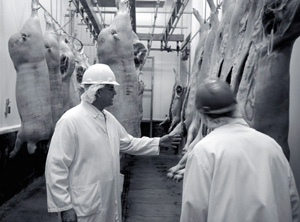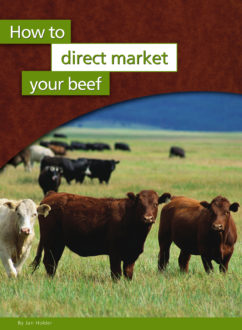
Finding a processing facility can be really hard or really easy, depending where you live and what your needs are. Processing plants vary enormously in the types of processing they do. You need to have a pretty good idea of what your needs are before you go looking for a plant because the evaluation and site vis-its you’ll need to do are very time-consuming.
Check your state Department of Agriculture for a list of facilities in your state. This list will tell you if the plant is state or federally inspected and whether it is a kill plant, a processing plant, or both. A kill plant actually kills the animals, hangs and chills them. A processing plant cuts up the carcasses.
First, target only the ones that do both killing and processing. You don’t want to truck your meat from one plant to another if you can avoid it. Then call them up and find out exactly what they do. A lot of plants are very specialized and only serve a particular market.
Then go visit them. No matter what they tell you on the phone, nothing replaces a site inspection. Pay attention to the details. Are their offices clean? Are the employees happy? Strike up conversations with everyone you can. Ask them how long they have worked there, what they do, and how they like their jobs. Write down the names of their equipment; ask them about the throughput per hour, day and week in every area of the operation. Ask them who their customers are. Ask for references. Ask to meet their inspector.
The good plants will be very open. They will show you everything; they will be proud of their plant. The bad ones will be obvious after just the first few minutes. They won’t want you talking to anyone. They will ask you why you need that information. They won’t give you specifics. They will act insulted that you questioned their integrity.
Run away as fast as you can.
Once you have it narrowed down, get pricing on the work you want them to do. Be very specific. Tell them what products you want, exactly how you want them cut, how each cut is to be packaged, boxed and labeled, and where and when your shipment will be delivered.
For us, it was pretty hard. We needed a federally inspected plant (because our products cross state lines, and our client’s insurance demanded federal, not state inspection), that could kill and custom-process. It also had to be able to separate our beef from other beef, because of our grass-fed label. We found only three federally inspected killing and processing facilities in the state that would custom-process for us. So keep in mind that even if your product doesn’t cross state lines, you may still need a federally inspected plant.
We have found that with increasing frequency, a restaurant or store’s insurance carrier requires them to only sell federally inspected products.
So don’t assume that state inspection is acceptable unless you ask your potential client.
Most large federal plants will not deal with you. They aren’t interested in cleaning their machines so that their meat does not contaminate yours. They do not want the hassle of having to keep your meat in a separate area from the conventional beef. They do not want your few animals gumming up their massive assembly line.
We now have most of our processing done at the University of Arizona Meat Science Lab. The plant is sparkling clean, it has great equipment, and the person who runs it has been very helpful to us.
Our jerky and marinated roasts are processed at another plant. We have to truck the meat in refrigerated vehicles. We are using a sausage and hot dog plant in Phoenix that does a great job and has a wonderful little old man offering you great samples.
However, the plants we use are okay for now, but not perfect. We cannot serve many clients because we do not have the right kind of processing available to us.
MAKING SURE YOU GET IT DONE RIGHT
Keeping an inventory of processed beef is next to impossible. The yield of every carcass is a little different, and you might cut up different carcasses differently. However, keeping good records keeps meat from disappearing.
We’ve created a form that helps us:
- Communicate with the processing plant about how we want our carcass cut.
- Create a visual check list to make sure we’ve accounted for the whole carcass.
- Inventory cut beef.
- Keep the processing plant honest.
- See trends to predict yields of certain cuts.
- Access written records if there is a problem
- Create carcass performance data that can be taken to a breeder.
You may want to consider having your carcasses graded, at least occasionally, to help you learn more about your cattle. Our processor will do it for free on an unofficial basis. An official USDA grader charges a fee.
FEDERAL INSPECTORS
All federally inspected processing facilities will have a federal inspector who maintains a permanent office within the facility. They are always present when the slaughter is done and they regulate the way the meat is handled within the facility. They also enforce the rules concerning the transfer of meat between facilities. For instance, if you transfer meat from a federally inspected facility to a state-inspected facility, it is then considered only state-inspected.
Like everyone else, there are good inspectors and bad inspectors. Yet, every one of them wields a lot of power. Most of their interaction will be with the operators of the processing plant, but you will need to deal with them a little. Be nice to them. They can be a great help, or they can make your life miserable. For instance, the amount of meat that you can give away is actually regulated. Samples are all supposed to be marked “sample,” and the amount may not exceed 2,000 pounds per year. Now, if you have a good relationship with your inspector, he probably is not going to inspect and count each and every sample that you take from the processing plant, but he certainly has the power to do so.
